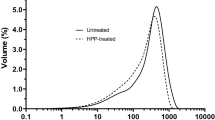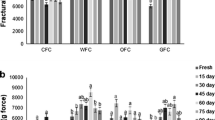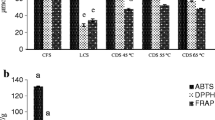Abstract
Grape skins recovered from winemaking by-products were investigated for use as sustainable, antioxidant fiber-rich ingredient for the innovation of low-energy dense tomato puree. Six tomato purees fortified with grape skin antioxidant fiber, with varying particle size distribution, and two control tomato purees were studied. Physical parameters of purees were analyzed upon mixing and either an intensive heat treatment or an optimized heat treatment designed to achieve six decimal reductions of a target microorganism (Alicyclobacillus acidoterrestris) as recommended for pasteurization of acidic fruit products. Mixing of grape skin antioxidant fiber with tomato purees led to a decrease in both surface-weighted mean diameter (Sauter mean diameter, d(3,2)) and volume-weighted mean diameter (d(4,3)) values and an increase in span. Changes in these descriptors were most significant in purees added with the smallest particle sizes. Thermal stabilization of purees slightly decreased the d(3,2) values further and increased d(4,3) values, suggesting concomitant occurrence of particle disaggregation and formation of flocs within the food matrix. Phenolic solubility was inversely correlated to d(3,2) values. Bostwick consistency, storage (G′) and loss (G″) moduli, and complex viscosity (η*) increased in the fortified purees. The η* values displayed a positive correlation with d(4,3) values. Variations in Hunter colorimetric parameters were within the acceptability threshold. Overall, the information obtained provides knowledge to assist development of fiber-rich, low-energy dense fruit purees.





Similar content being viewed by others
References
Anthon, G. E., & Barrett, D. M. (2010). Change in tomato paste during storage and the effects of heating on consistency of reconstituted tomato paste. Journal of Texture Studies, 41, 262–278.
AOAC. (1990). Official Methods of Analysis (15th ed.). Washington, DC: Association of Official Analytical Chemists.
Augusto, P. E. D., Falguera, V., Cristianini, M., & Ibarz, A. (2011). Influence of fibre addition on the rheological properties of peach juice. International Journal of Food Science and Technology, 46, 1086–1092.
Bayod, E., & Tornberg, E. (2011). Microstructure of highly concentrated tomato suspensions on homogenisation and subsequent shearing. Food Research International, 44, 755–764.
Bevilacqua, A., & Corbo, M. R. (2011). Characterization of a wild strain of Alicyclobacillus acidoterrestris: heat resistance and implications for tomato juice. Journal of Food Science, 76, 130–136.
Córdoba, A., del Mar Camacho, M., & Martínez-Navarrete, N. (2012). Rheological behaviour of an insoluble lemon fibre as affected by stirring, temperature, time and storage. Food and Bioprocess Technology, 5, 1083–1092.
Deng, Q., Penner, M. H., & Zhao, Y. (2011). Chemical composition of dietary fiber and polyphenols of five different varieties of wine grape pomace skins. Food Research International, 44, 2712–2720.
Earle, R. L., & Earle, M. D. (2003). Fundamentals of food reaction technology. Surrey: Leatherhead Food International Limited.
Elleuch, M., Bedigian, D., Roiseux, O., Besbes, S., Blecker, C., & Attia, C. (2011). Dietary fibre and fibre-rich by-products of food processing: Characterisation, technological functionality and commercial applications: A review. Food Chemistry, 124, 411–421.
Gambetta, J. M., Bastian, S. E. P., Cozzolino, D., & Jeffery, D. W. (2014). Factors influencing the aroma composition of Chardonnay wines. Journal of Agricultural and Food Chemistry, 62, 6512–6534.
Giner, M. J., Hizarci, O., Marti, N., Saura, D., & Valero, M. (2013). Novel approaches to reduce brown pigment formation and color changes in thermal pasteurized tomato juice. European Food Research and Technology, 236, 507–515.
Han, J., Britten, M., St-Gelais, D., Champagne, C. P., Fustier, P., Salmieri, S., & Lacroix, M. (2011). Effect of polyphenolic ingredients on physical characteristics of cheese. Food Research International, 44, 494–497.
Igual, M., Contreras, C., Camacho, M. M., & Martínez-Navarrete, N. (2014). Effect of Thermal Treatment and Storage Conditions on the Physical and Sensory Properties of Grapefruit Juice. Food and Bioprocess Technology, 7, 191–203.
Imai, E., Saito, K., Hatakeyama, M., Hatae, K., & Shimada, A. (1998). Effect of physical properties of food particles on the degree of graininess perceived in the mouth. Journal of Texture Studies, 30, 59–88.
ISO 13320:2009. Particle size analysis—laser diffraction methods. Geneve, CH: International Standard Organization.
Juszczak, L., Oczadły, Z., & Gałkowska, D. (2013). Effect of Modified Starches on Rheological Properties of Ketchup. Food and Bioprocess Technology, 6, 1251–1260.
Lavelli, V., Pagliarini, E., Ambrosoli, R., Minati, J. L., & Zanoni, B. (2006). Physicochemical, microbial, and sensory parameters as indices to evaluate the quality of minimally-processed carrots. Postharvest Biology and Technology, 40, 34–40.
Li, H., Deng, Z., Liu, R., Young, J. C., Zhu, H., Loewen, S., et al. (2011). Characterization of phytochemicals and antioxidant activities of a purple tomato (Solanumlycopersicum L.). Journal of Agricultural and Food Chemistry, 59, 11803–11811.
Lopez-Oliva, M. E., Agis-Torres, A., Goni, I., & Munoz-Martinez, E. (2010). Grape antioxidant dietary fibre reduced apoptosis and induced a pro-reducing shift in the in the glutathione redox state of the rat proximal colonic mucosa. British Journal of Nutrition, 103, 1110–1117.
Mann, J. I., & Cummings, J. H. (2009). Possible implications for health of the different definitions of dietary fibre. Nutrition, Metabolism & Cardiovascular Diseases, 19, 226–229.
Massa, A., Gonzales, C., Maestro, A., Labanda, J., & Ibarz, A. (2010). Rheological characterization of peach purees. Journal of Texture Studies, 41, 532–548.
Mildner-Szkudlarz, S., Zawirska-Wojtasiak, R., Szwengiel, A., & Pacynski, M. (2011). Use of grape by-product as a source of dietary fiber and phenolic compounds in sourdough mixed rye. International Journal of Food Science and Technology, 46, 1485–1493.
Mildner-Szkudlarz, S., Bajerska, J., Zawirska-Wojtasiak, R., & Gòrecka, D. (2013). White grape pomace as a source of dietary fiber and polyphenols and its effect on physical and nutraceutical characteristics of wheat biscuits. Journal of the Science of Food and Agriculture, 93, 389–395.
Moelants, K. R. N., Jolie, R. P., Palmers, S. K. J., Cardinaels, R., Christiaens, S., Van Buggenhout, S., et al. (2013). The effects of process-induced pectin changes on the viscosity of carrot and tomato sera. Food and Bioprocess Technology, 6, 2870–2883.
Moelants, K. R. N., Cardinaels, R., Jolie, R. P., Verrijssen, T. A. J., Van Buggenhout, S., Van Loey, A. M., et al. (2014a). Rheology of concentrated tomato-derived suspensions: effects of particle characteristics. Food and Bioprocess Technology, 7, 248–264.
Moelants, K. R. N., Cardinales, R., Van Bruggenhout, S., Van Loey, A. M., Moldenares, P., & Hendricx, M. E. (2014b). A Review on the relationships between Processing, Food Structure and Rheological Properties of Plant-Tissue-based Food Suspensions. Comprehensive Review in Food Science and Food Safety, 13, 241–260.
Nisha, P., Singhal, R. S., & Pandit, A. B. (2011). Kinetic modelling of colour degradation in Tomato Puree (Lycopersicon esculentum L.). Food and Bioprocess Technology, 4, 781–787.
Page, D., Van Stratum, E., Degrou, A., & Renard, C. M. G. C. (2012). Kinetics of temperature increase during tomato processing modulate the bioaccessibility of lycopene. Food Chemistry, 135, 2462–2469.
Palzer, S. (2009). Food structures for nutrition, health and wellness. Trends in Food Science & Technology, 20, 194–200.
Perez-Jimenez, J., Serrano, J., Tabernero, M., Diaz-Rubio, M. E., Arranz, S., Garcia-Diz, L., Goni, I., & Saura-Calixto, F. (2008). Effects of grape antioxidant dietary fiber in cardiovascular disease risk factors. Nutrition, 24, 646–653.
Rao, M. A. (1999). Rheology of Fluid and Semisolid Foods. Principles and Applications. Maryland: Aspen Publishers, Inc.
Regulation (EC) N. 1924/2006, 20.12.2006 on nutrition and health claims made on foods. Official Journal of the European Union, L 404/9.
Ribeiro, B., Cardoso, C., Silva, H. A., Serrano, C., Cristina Ramos, C., Santos, P. C., Mendes, R. (2013). Effect of grape dietary fibre on the storage stability of innovative functional seafood products made from farmed meager (Argyrosomusregius). International Journal of Food Science and Technology, 48, 10–21.
Sagdic, O., Ozturk, I., Ozkan, G., Yetim, H., Ekici, L., & Yilmaz, M. T. (2011). RP-HPLC–DAD analysis of phenolic compounds in pomace extracts from five grape cultivars: Evaluation of their antioxidant, antiradical and antifungal activities in orange and apple juices. Food Chemistry, 126, 1749–1758.
Sagdic, O., Ozturk, I., Cankurt, H., & Tornuk, F. (2012). Interaction between some phenolic compounds and probiotic bacterium in functional ice cream production. Food and Bioprocess Technology, 5, 2964–2971.
Sanchez, M. C., Valencia, C., Gallegos, C., Ciruelos, A., & Latorre, A. (2002). Influence of processing on the rheological properties of tomato paste. Journal of the Science of Food and Agriculture, 82, 990–997.
Saura-Calixto, F. (1998). Antioxidant dietary fiber product: a new concept and a potential food ingredient. Journal of Agricultural and Food Chemistry, 46, 4303–4306.
Sayago-Ayerdi, S. G., Brenes, A., & Goni, I. (2009). Effect of grape antioxidant dietary fiber on the lipid oxidation of raw and cooked chicken hamburgers. LWT - Food Science and Technology, 42, 971–976.
Silva, F. V. M., & Gibbs, P. (2004). Target selection in designing pasteurization processes for shelf-stable high-acid fruit products. Critical Reviews in Food Science and Nutrition, 44, 353–360.
Singleton, V. L., Orthofer, R., & Lamuela-Raventos, R. M. (1999). Analysis of total phenols and other oxidation substrates and antioxidants by means of Folin-Ciocalteu reagent. Methods in Enzymology, 299, 152–178.
Sri Harsha, P. S. C., Gardana, C., Simonetti, P., Spigno, G., & Lavelli, V. (2013). Characterization of phenolics, in vitro reducing capacity and anti-glycation activity of red grape skins recovered from winemaking by-products. Bioresource Technology, 140, 263–268.
Sri Harsha, P. S. C., Lavelli, V., & Scarafoni, A. (2014). Protective ability of phenolics from white grape vinification by-products against structural damage of bovine serum albumin induced by glycation. Food Chemistry, 156, 220–226.
Tiziani, S., & Vodovotz, Y. (2005). Rheological effects of soy protein addition to tomato juice. Food Hydrocolloids, 19, 45–52.
Tseng, A., & Zhao, Y. (2013). Wine grape pomace as antioxidant dietary fiber for enhancing nutritional value and improving storability of yogurt and salad dressing. Food Chemistry, 138, 356–365.
Walstra, P. (2003). Physical chemistry of foods. New York: Marcel Dekker.
Zanoni, B., Pagliarini, E., Giovanelli, G., & Lavelli, V. (2003). Modelling the effects of thermal sterilization on the quality of tomato puree. Journal of Food Engineering, 56, 203–206.
Acknowledgments
This research is supported by AGER (project number 2010–2222).
Conflict of Interest
None
Author information
Authors and Affiliations
Corresponding author
Rights and permissions
About this article
Cite this article
Lavelli, V., Sri Harsha, P.S.C., Mariotti, M. et al. Tuning Physical Properties of Tomato Puree by Fortification with Grape Skin Antioxidant Dietary Fiber. Food Bioprocess Technol 8, 1668–1679 (2015). https://doi.org/10.1007/s11947-015-1510-3
Received:
Accepted:
Published:
Issue Date:
DOI: https://doi.org/10.1007/s11947-015-1510-3




